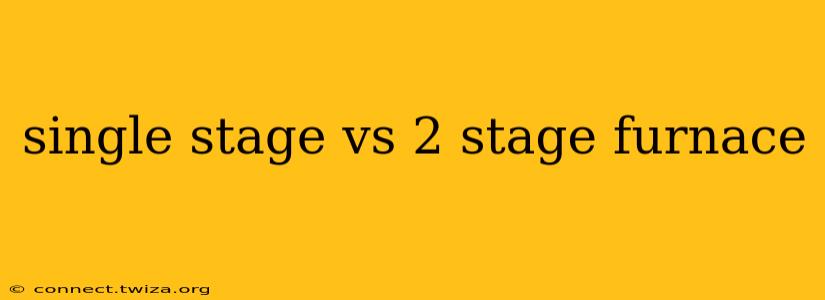Choosing the right furnace is a crucial decision for homeowners, impacting both comfort and energy bills. Two main types dominate the market: single-stage and two-stage furnaces. Understanding their differences is key to making an informed choice. This comprehensive guide will delve into the specifics, helping you determine which furnace best suits your needs and budget.
What is a Single-Stage Furnace?
A single-stage furnace operates in a simple, on-off manner. It either runs at full capacity or is completely off. Think of it like a light switch – it's either on or off, with no in-between. While straightforward and typically less expensive upfront, this all-or-nothing approach can lead to temperature swings and less consistent comfort. The furnace cycles frequently between blasting hot air and being completely shut off, leading to potentially higher energy consumption.
What is a Two-Stage Furnace?
A two-stage furnace offers a more refined approach to heating. It operates at two distinct levels: a low-speed setting (approximately 60% capacity) and a high-speed setting (100% capacity). The furnace intelligently switches between these stages based on the temperature requirements, providing a gentler, more even heating experience. This modulation minimizes temperature fluctuations, resulting in a more consistent and comfortable home environment.
Single Stage vs. 2 Stage Furnace: Key Differences Summarized
| Feature | Single-Stage Furnace | Two-Stage Furnace |
|---|---|---|
| Operation | On/Off | Two stages: low and high |
| Comfort Level | Less consistent, more temperature swings | More consistent, less temperature swings |
| Energy Efficiency | Generally less efficient | Generally more efficient |
| Upfront Cost | Typically lower | Typically higher |
| Maintenance | Generally lower | Slightly higher |
| Lifespan | Similar to two-stage | Similar to two-stage |
How Much More Efficient is a Two-Stage Furnace?
While the exact efficiency increase varies depending on factors like home size and insulation, two-stage furnaces generally offer significant energy savings. Their ability to maintain consistent temperatures through modulated heating reduces the number of times the furnace needs to cycle on and off at full blast. This gentler operation reduces wear and tear on components, potentially extending the furnace's lifespan.
Is a Two-Stage Furnace Worth the Extra Cost?
The higher upfront cost of a two-stage furnace is often offset by long-term energy savings and increased comfort. If consistent temperature and reduced energy bills are priorities, the investment in a two-stage system is often worthwhile. However, for those on a tight budget, a single-stage furnace may be a more financially feasible option in the short term.
Which Furnace is Better for Allergies?
Both single-stage and two-stage furnaces can be equipped with air filtration systems. However, the consistent, gentler operation of a two-stage furnace can contribute to better indoor air quality. Less frequent cycling means less dust and allergens are disturbed, improving air quality for allergy sufferers. Consider pairing either system with a high-efficiency air filter for optimal results.
What About Variable-Speed Furnaces?
Beyond single and two-stage furnaces, there are variable-speed furnaces. These offer even finer control and modulation, providing the most consistent comfort and highest energy efficiency. However, they come with the highest upfront cost.
Which Type of Furnace is Right for Me?
The best choice depends on your individual priorities and circumstances. Consider these factors:
- Budget: Single-stage furnaces are less expensive upfront.
- Comfort Preferences: Two-stage and variable-speed furnaces provide more consistent comfort.
- Energy Efficiency: Two-stage and variable-speed furnaces offer better energy savings in the long run.
- Home Size and Insulation: Larger homes or those with poor insulation might benefit more from a two-stage or variable-speed furnace.
- Allergies: Both types can be paired with air filters, but the gentler operation of two-stage furnaces may be better for allergy sufferers.
By carefully weighing these factors, you can confidently choose the furnace that best meets your individual needs and provides years of reliable, comfortable heating. Consulting with a qualified HVAC professional is always recommended to get personalized advice based on your home's specific requirements.
